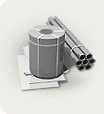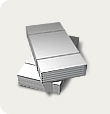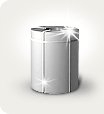The production of the vast majority of parts made from steel sheets begins with a blanking operation, during which a solid sheet is cut into individual parts. Such steel elements can have various shapes and can be immediately either a finished part or just a blank, which will still have to work very long and hard.
There are quite serious requirements for cutting metal: this process must be inexpensive, ensure sufficient accuracy of the operation and a minimum amount of waste.
There are currently four main ways in which steel sheets are cut:
- oxy-fuel;
- plasma;
- waterjet;
- laser.
1. Oxy-fuel cutting of metal.
Oxy-fuel cutting is a traditional method and implies heating the metal to the melting point and then blowing it out.
This technology has been used for a very long time (more than a century), but it is still widely used, since its implementation does not require expensive equipment. The disadvantages of this method are low speed and accuracy.
2. Plasma cutting .
Plasma cutting of a sheet is a more modern method that can significantly improve cut quality and speed. It is widely used in modern industry in batch production.
A rather significant advantage of this cutting method is the relative availability of equipment.
3. Waterjet cutting of metal .
At the heart of waterjet cutting is a stream of water that is mixed with an abrasive and a thin jet, the diameter of which does not exceed the diameter of a human hair. The water flow is fed to the cutting point under high pressure, up to 5000 bar.
This method provides a cut accuracy of up to 0.1 millimeter, and the cut surface itself is perfectly clean, which makes it possible to prevent the need for subsequent finishing (with the exception of the metal bending service, which is quite understandable). In addition, it should be noted that using waterjet cutting it is possible to cut material up to 300 millimeters thick.
4. Laser cutting of metal .
Laser cutting of metal is very, very common today. It implies the use of a laser beam that generates a special laser installation and which has a high power. This allows you to cut with a high degree of accuracy almost any metal and alloy.
It should be noted, however, that the formed edges then do not require further processing. A clear advantage is the ability to immediately receive finished products.





